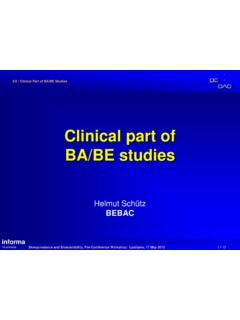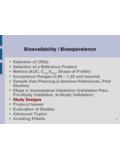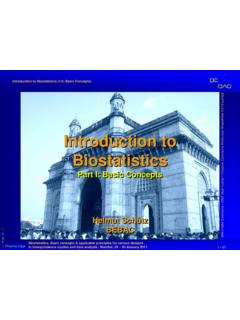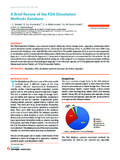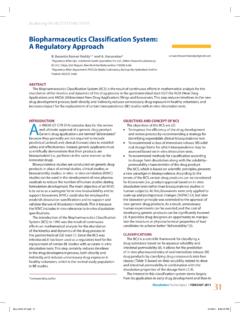Transcription of Overview of Dissolution for BA/BE - bebac.at
1 Biopharmaceutics Classification System based on Solubility/Permeability Biowaivers for BCS I Drugs Discussion of BCS III Drugs Models establishing in vivo-in vitro Correlations (IVIVC Levels A-C) Overview of Dissolution for BA/BE1 Biopharmaceutics Classification System based on Solubility/Permeability Class ISolubility Permeabilty Class IISolubility Permeabilty Class IIIS olubility Permeabilty Class IVSolubility Permeabilty Amidon, , Lennern s, H., Shah, and J. R. Crison;A theoretical basis for a biopharmaceutics drug classification: The correla-tion of in vitro drug product Dissolution and in vivo Res. 12(3), 413-420 (1995) Overview of Dissolution for BA/BE2 Biopharmaceutics Classification System based on Solubility/Permeability Dissolution rate has a negligible impact on bio-availability of highly soluble and highly perme-able (BCS Class I) drugs when their formula-tion s Dissolution is sufficiently , , Gillespie, , Hussain, and Amidon;The effect of in vivo Dissolution , gastric emptying rate, and intestinal transit time on the peak concentration and area-under-the-curve of drugs with diffe-rent gastrointestinal Res.
2 16(2), 272-280 (1999) Overview of Dissolution for BA/BE3 Biopharmaceutics Classification System based on Solubility/Permeability Various regulatory agencies allow bioequiva-lence of formulations of BCS Class I drugs to be demonstrated by in vitro Dissolution ( biowaiver ).United States Food and Drug Administration;Guidance for Industry: Waiver of In Vivo Bioavailability and Bioequivalence Studies for Immediate-Release Solid Oral Dosage Forms Based on a Bio-pharmaceutics Classification System. (August 2000)European Agency for the Evaluation of Medicinal Products / Committee for Proprietary Medicinal Products;Note for guidance on the investigation of bioavailability and bioequivalence. CPMP/EWP/QWP/1401/98 (July 2001) Overview of Dissolution for BA/BE4 Biopharmaceutics Classification System based on Solubility/Permeability Biowaivers for BCS I Drugs Discussion of BCS III Drugs Models establishing in vivo-in vitro Correlations (IVIVC Levels A-C) Overview of Dissolution for BA/BE5 Biowaivers for BCS I Drugs Of the 130 orally administered drugs on the WHO list of essential medicines 61 could be classified with certainty, 28 could be provisionally classified, and 41 could not be Class I were: % (certain, n=61) % (provisional, n=28) Overview of Dissolution for BA/BE6 Biowaivers for BCS I Drugs Solubility Based on the highest dosage strength of an IR product Soluble in max.
3 250 ml of aqueous media pH range (FDA), (EMEA) Permeability Fa (fraction of dose absorbed) 90 % human in-vivo studies human in-vitro studies (CACO-2 cell culture) Absence of evidence suggesting instability in the GI tractOverview of Dissolution for BA/BE7 Biowaivers for BCS I Drugs Dissolution 85 % of labeled content dissolved within 30 minutes using USP Apparatus I (100 rpm) orUSP Apparatus II (50 rpm) in a volume of 900 ml N HCl or Simulated Gastric Fluid USP without enzymes pH buffer pH buffer or Simulated Intestinal Fluid USP without enzymes 12 dosage units Sampling intervals: FDA 4, EMEA 3 Overview of Dissolution for BA/BE8 Biowaivers for BCS I Drugs Excipients Generally, excipients will not affect the rate or extent of absorption of BCS I drugs.
4 Quantity of excipients should be consistent with the intended function ( , lubricant). New excipients / atypically large amounts of commonly used excipients: additional information. Relative BA: aqueous solution as reference The review division of FDA should by contacted if: large quantities of surfactants ( , polysorbate 80) and sweeteners ( , mannitol or sorbitol) Overview of Dissolution for BA/BE9 Biowaivers for BCS I Drugs Similarity Factor f2 Not necessary if 85 % dissolved in 15 minutesin all three Dissolution media (FDA). Not more than one mean value of >85% dissolved (EMEA). f2 = 50 log { [ 1 + (1/n) (Rt Tt)2 ] 100} Coefficient of Variation 20 % at earlier time points (FDA; EMEA no restriction) 10 % at other time points (FDA; EMEA <10 %) Products are considered similar if f2 50 Overview of Dissolution for BA/BE10 Biowaivers for BCS I Drugs Similarity factor f2 is an arbitrary measure (not a statistic).
5 Therefore different number of sampling times, and/or different sampling times itself may lead to different , , Ma, and Chow;Statistical Evaluation of Similarity Factor f2 as a Criterion for Assessment of Similarity Between Dissolution Information Journal 31, 1255-1271 (1997) Overview of Dissolution for BA/BE11 Biowaivers for BCS I Drugs Effect of different number of sampling timesOverview of Dissolution for [h]dissolved [%]ReferenceTestf2= [h]dissolved [%]ReferenceTestf2= Biowaivers for BCS I Drugs Effect of different sampling timesOverview of Dissolution for [h]dissolved [%]ReferenceTestf2= [h]dissolved [%]ReferenceTestf2= Biowaivers for BCS I Drugs Proposed extensions Current guideline considered conservative (class boundaries of solubility and permeability): permeability:reduce limit of Fa from to solubility.
6 Change pH from 1 to relax side conditionsPolli, et al.;Summary workshop report: Biopharmaceutics classification system implementation challenges and extension Pharm. Sci. 93(6), 1375-1381 (2004) Overview of Dissolution for BA/BE14 Biopharmaceutics Classification System based on Solubility/Permeability Biowaivers for BCS I Drugs Discussion of BCS III Drugs Models establishing in vivo-in vitro Correlations (IVIVC Levels A-C) Overview of Dissolution for BA/BE15 Discussion of BCS III Drugs Of the 130 orally administered drugs on the WHO list of essential medicines 61 could be classified with certainty, 28 could be provisionally classified, and 41 could not be Class III were: % (certain, n=61) % (provisional, n=28) Overview of Dissolution for BA/BE16 Discussion of BCS III Drugs As proposed by Amidon biowaivers may also be considered for BCS Class III drugs.
7 High Permeability Fa changed from 90 %to 85 % (or 70 %). Allow Waivers at any strength. Reduce number of permeability reference drugs to 10 or 15 (rather than 20). Amidon;BCS: The New Science of 2005, London, 24-26 October 2005 Overview of Dissolution for BA/BE17 Discussion of BCS III Drugs Example: Acetaminophen (paracetamol) Literature data review: BCS Class III Differences in composition seldom, if ever, have an effect on the extent of absorption. Some studies show differences in rate of absorption between brands and formulations. In particular, sodium bicarbonate, present in some drug products, was reported to give an increase in the rate of absorption, probably caused by an effect on gastric of Dissolution for BA/BE18 Discussion of BCS III Drugs Example: Acetaminophen (paracetamol) In view of Marketing Authorizations (MAs) given in a num-ber of countries to acetaminophen drug products with rapid onset of action, it is concluded that differences in rate of absorption were considered therapeutically not relevant by the Health Authorities.
8 Moreover, in view of its therapeutic use, its wide therapeu-tic index and its uncomplicated pharmacokinetic properties, in vitro Dissolution data collected according to the relevant Guidances can be safely used for declaring bioequivalence (BE) of two acetaminophen of Dissolution for BA/BE19 Discussion of BCS III Drugs Example: Acetaminophen (paracetamol) Accepting a biowaiver for IR acetaminophen solid oral drug products is considered scientifically justified, if the test product contains only those excipients reported in this paper in their usual amounts and the test product is rapidly dissolving, as well as the test product fulfils the criterion of similarity of Dissolution profiles to the reference , L., Reppas, C., Dressman, , Amidon, , Junginger, , Midha, , Shah, , Stavchansky, and Barends;Biowaiver monographs for immediate release solid oral dosage forms: Acetaminophen (paracetamol).
9 J. Pharm. Res. 95(1), 4-14 (2005) Overview of Dissolution for BA/BE20 Biopharmaceutics Classification System based on Solubility/Permeability Biowaivers for BCS I Drugs Discussion of BCS III Drugs Models establishing in vivo-in vitro Correlations (IVIVC Levels A-C) Overview of Dissolution for BA/BE21 Models etablishing in vivo-in vitro Correlations (IVIVC Levels A-C) Level APoint-to-point relationship between the in vitro Dissolution curve and the in vivo dissol. curves generated by deconvolution of plasma level data or by other appropriate methods (Wagner-Nelson, Loo-Riegelman, numeric deconvolution). Overview of Dissolution for BA/BE22 Models etablishing in vivo-in vitro Correlations (IVIVC Levels A-C) Level A One formulation tested at different Dissolution conditions compared with a plain aqueous solution of the active substance.
10 Single study with a cross-over design. In vitro conditions producing a Dissolution profile similar to the in vivo input rate. If in vitro Dissolution is faster/slower than in vivo input rate, introduction of a uniform time scaling factor can be of Dissolution for BA/BE23 Models etablishing in vivo-in vitro Correlations (IVIVC Levels A-C) Level BOne point relationship between Mean in vitro Dissolution time of the product / either the mean in vivo residence time or the mean in vivo Dissolution time by using the principles of statistical moment analysis; or In vitro Dissolution rate constant / the absorption rate constant of Dissolution for BA/BE24 Models etablishing in vivo-in vitro Correlations (IVIVC Levels A-C) Level COne point relationship between amount dissolv-ed in vitro at a particular time / one mean PK parameter.


